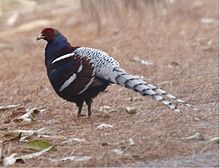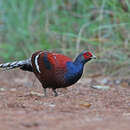Biology
provided by Arkive
Hume's pheasant is polygynous, with a cock (male pheasant) usually being accompanied by two to three hens (7). The breeding season is thought to last from February to July, with egg-laying beginning in March (2) (7). Females lay a clutch of six to ten eggs in a nest of dried leaves, twigs and feathers on the ground, and are solely responsible for their full 24 to 28 days incubation (2) (7).
This pheasant has been recorded feeding on fruit, seeds, leaves, buds and roots of over 40 plant species, as well as on worms, snails and insects (2) (7). While adults feed primarily on vegetable matter, insects form the bulk of the diet for young birds (2) (7).
Conservation
provided by Arkive
Hume's pheasant is legally protected throughout its range, and populations exist in several protected areas (8). However, hunting and habitat loss evidently persist in at least some of these reserves and national parks, particularly in north-west Thailand, Myanmar and north-east India. Regulations against poaching and habitat encroachment therefore need to be more strictly enforced, especially in protected areas supporting significant populations (7).
Description
provided by Arkive
Although closely resembling Elliot's pheasant (Syrmaticus ellioti), the male of this species can be distinguished by the deep chestnut colour of its abdomen and flanks, and the glossy steel-blue lustre of its throat, neck, upper breast and wing bar (2) (4) (5). The crown and nape of the neck are olive-brown, and the back and wings are a rich metallic chestnut-bronze with purplish tinge, with three conspicuous white bars on the upper wing. In stark contrast to this rich russet colour, the lower back and rump are boldly barred dark blue and white, while the long tail is silvery-grey with black and chestnut bars (4). Like other long-tailed pheasants (Syrmaticus spp.), this bird has noticeable red face wattles around its eyes (5) (6). The female is greyish-buff with brown, black and tan markings (4) (6).
Habitat
provided by Arkive
Inhabits open dry evergreen (mainly oak), coniferous (mainly pine) and mixed coniferous-broadleaf forests on steep rocky hillsides, interrupted by scrub and grassy clearings (8), between 740 and 2,400 metres above sea level (2). Roosts are often located along ridges, and in other relatively open areas (8).
Range
provided by Arkive
Found in northeast India, north and east Myanmar, south-western China and northwest Thailand (4). Two subspecies exist, with S. h. humiae inhabiting the mountains of extreme northeast India east to western Myanmar, south to the Irrawaddy River, and S. h. burmanicus occurring within southern China, northern and eastern Myanmar and extreme northern Thailand (2) (7).
Status
provided by Arkive
Classified as Near Threatened (NT) on the IUCN Red List 2007 (1) and listed on Appendix I of CITES (3).
Threats
provided by Arkive
Like many pheasants in East Asia, Hume's pheasant is undergoing a continuing decline across much its range in the face of heavy exploitation and habitat loss (8). This bird is widely hunted for food, particularly by hill tribes, including in protected areas, and its preference for paths, small clearings and open woodlands renders it particularly exposed and susceptible to hunting pressure (7). However, the bird's persistence in northern India and Thailand, where it is heavily exploited, suggests that it is fairly resilient and can withstand hunting to some degree (8). Suitable habitat has been destroyed and severely fragmented by extensive shifting cultivation, conversion to agriculture, logging and uncontrolled annual burning in Myanmar, China and India. Agricultural intensification, road-building and other development projects have diminished habitat in northern Thailand, where reforestation of large areas with dense conifer plantations may also pose a threat (7) (8).
Mrs. Hume's pheasant
provided by wikipedia EN
Mrs. Hume's pheasant (Syrmaticus humiae)(Meitei: Nongin; literally, "one who follows the track of rain"[3][4][5]), also known as Hume's pheasant or the bar-tailed pheasant, is a large, up to 90 cm long, forest pheasant with a greyish brown head, bare red facial skin, chestnut brown plumage, yellowish bill, brownish orange iris, white wingbars and metallic blue neck feathers. The male has a long greyish white, barred black and brown tail. The female is a chestnut brown bird with whitish throat, buff color belly and white-tipped tail. E.
This rare and little known pheasant is found throughout forested habitats of the Mizoram, Patkai Range, Manipur, Yunnan and northern parts of Myanmar and Thailand. The diet consists mainly of vegetation matters. The female lays three to twelve creamy white eggs in nest of leaves, twigs and feathers.

Doi Lang Mountain - Thailand
The name commemorates Mary Ann Grindall Hume, wife of the British naturalist in India Allan Octavian Hume. It is the state bird of Mizoram and Manipur.[6][7]
Owing to ongoing habitat loss, fragmented population and being hunted for food, the Mrs. Hume's pheasant is evaluated as Near Threatened on the IUCN Red List of Threatened Species. It is listed on Appendix I of CITES.
References

- license
- cc-by-sa-3.0
- copyright
- Wikipedia authors and editors
Mrs. Hume's pheasant: Brief Summary
provided by wikipedia EN
Mrs. Hume's pheasant (Syrmaticus humiae)(Meitei: Nongin; literally, "one who follows the track of rain"), also known as Hume's pheasant or the bar-tailed pheasant, is a large, up to 90 cm long, forest pheasant with a greyish brown head, bare red facial skin, chestnut brown plumage, yellowish bill, brownish orange iris, white wingbars and metallic blue neck feathers. The male has a long greyish white, barred black and brown tail. The female is a chestnut brown bird with whitish throat, buff color belly and white-tipped tail. E.
This rare and little known pheasant is found throughout forested habitats of the Mizoram, Patkai Range, Manipur, Yunnan and northern parts of Myanmar and Thailand. The diet consists mainly of vegetation matters. The female lays three to twelve creamy white eggs in nest of leaves, twigs and feathers.

Doi Lang Mountain - Thailand
The name commemorates Mary Ann Grindall Hume, wife of the British naturalist in India Allan Octavian Hume. It is the state bird of Mizoram and Manipur.
Owing to ongoing habitat loss, fragmented population and being hunted for food, the Mrs. Hume's pheasant is evaluated as Near Threatened on the IUCN Red List of Threatened Species. It is listed on Appendix I of CITES.
- license
- cc-by-sa-3.0
- copyright
- Wikipedia authors and editors


 Doi Lang Mountain - Thailand
Doi Lang Mountain - Thailand